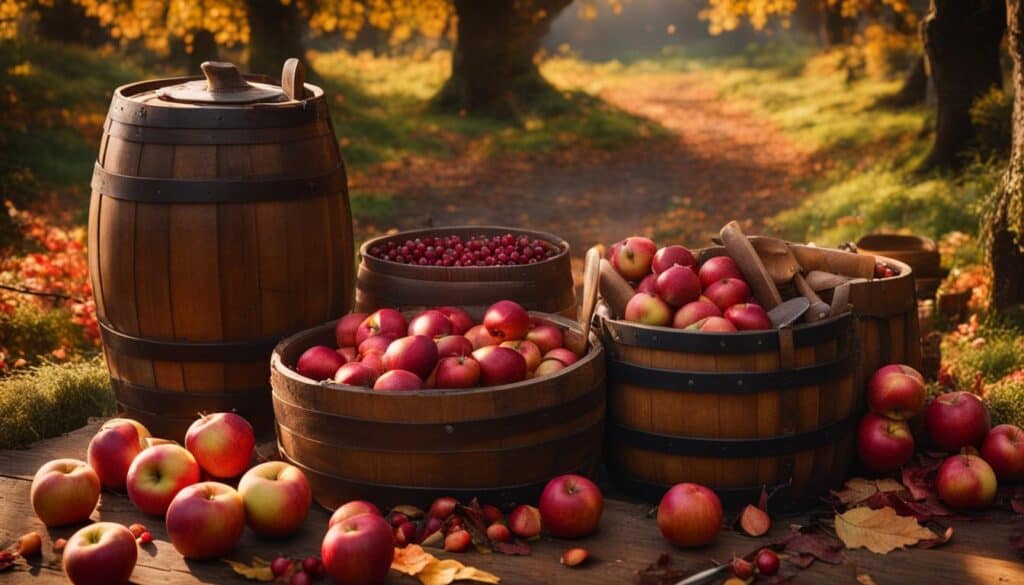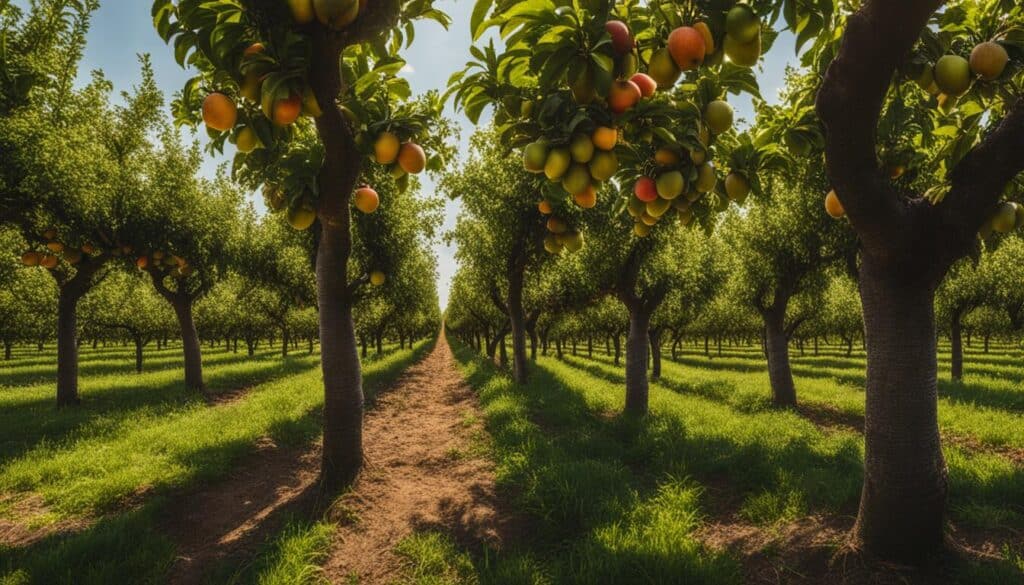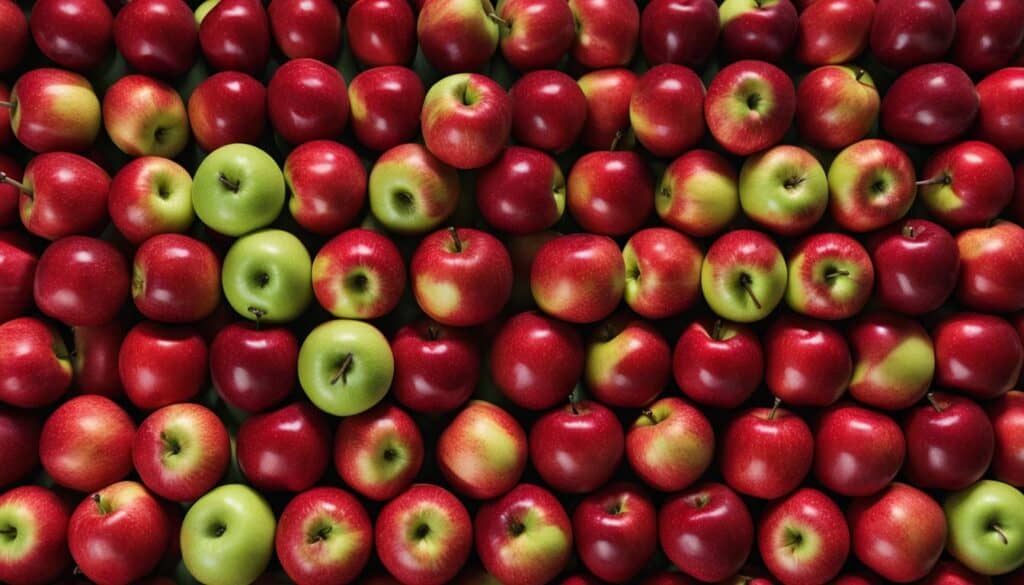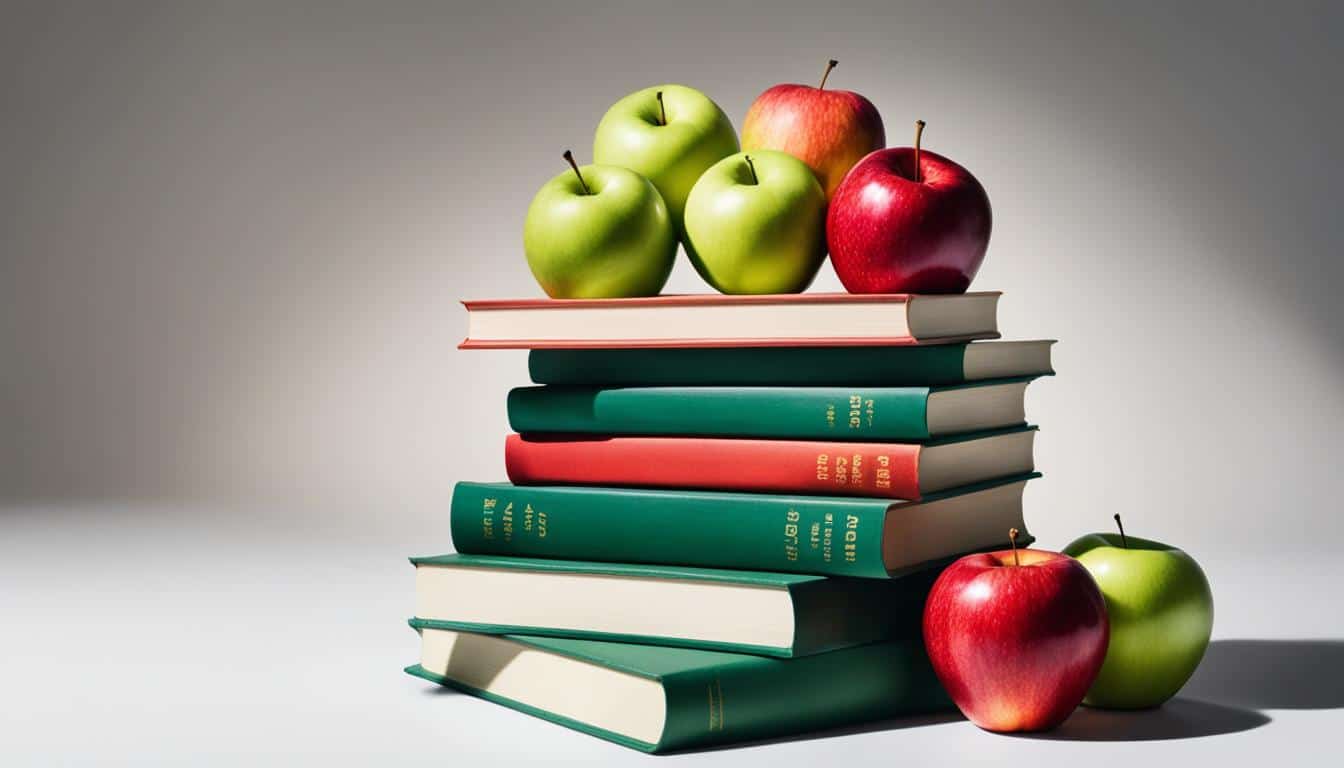As a fruit enthusiast, I am always fascinated by the world of apples. From their rich history to their diverse flavors, apples have captivated me like no other fruit. In my quest to explore everything about big apple fruit, I have discovered valuable insights and tips that I would love to share with fellow apple enthusiasts.
When it comes to identifying different apple varieties, I have learned that it can be quite challenging. The Montezuma Orchard Restoration Project (MORP) has been at the forefront of developing methods to help us distinguish one apple from another. Observing the tree, its bark, leaves, and shape is a great starting point. Tasting the fruit season after season also provides valuable clues for identification. Furthermore, delving into the history of apple cultivation in your area can offer valuable context and knowledge.
In the 1800s, America was home to a staggering 17,000 types of apples. However, this number has dwindled to only 6,000 today. Despite the loss of apple knowledge over time, we can turn to historical works such as Robert Hogg’s “The Fruit Manual,” S. A. Beach’s “Apples of New York,” and Edward Bunyard’s “Hardy Fruits” for guidance. By combining the wisdom from these works, we can create a comprehensive guide to identifying historic apple varieties in our local regions.
Join me on this exciting journey as we unravel the world of big apple fruit and tap into the rich heritage and flavors that apples have to offer.
Key Takeaways:
- Identifying different apple varieties can be challenging, but careful observation and tasting can yield valuable insights.
- Historical works like “The Fruit Manual” and “Apples of New York” provide valuable information on apple identification.
- Exploring the rich diversity and flavors of big apple fruit can be a fascinating journey for fruit enthusiasts.
- The Montezuma Orchard Restoration Project (MORP) is a valuable resource for apple enthusiasts.
- By combining knowledge from historical works and local research, we can create a comprehensive guide to identifying historic apple varieties in our areas.
Historic Apple Identification Methods
Apple identification can be a complex process due to the variation in apple morphology within the same variety. To truly get to know an apple, spending time observing the tree and its characteristics such as bark, leaves, and shape is essential. By doing so, you can develop a better understanding of the unique features that differentiate each apple variety.
Tasting the fruit season after season is another helpful method of apple identification. It allows you to build a comparative understanding of flavor, texture, and appearance, which are important attributes to consider for accurate identification.
In addition to personal observations, it’s beneficial to know the historically grown varieties in your area. Utilizing resources like old state and county fair lists, as well as horticultural reports, can provide valuable insights into the apple varieties that have thrived in your region.
Efforts have been made to develop botanical keys for apple identification, but the large number of apple characteristics makes this a challenging task. However, simplifying the identification process by grouping apples based on their use, season of ripening, or flavor profile can be helpful in narrowing down the options.
I believe that combining different identification methods and utilizing historical references can greatly enhance the accuracy and understanding of apple identification.
Historical works such as Robert Hogg’s “The Fruit Manual,” S. A. Beach’s “Apples of New York,” and Edward Bunyard’s “Hardy Fruits” offer valuable insights and classification methods for apple identification. These resources serve as a guide, providing information on apple culture, apple varieties, and apple morphology, allowing enthusiasts like me to delve deeper into the world of apples.
Common Characteristics for Apple Identification
| Characteristic | Description |
|---|---|
| Size | The overall size of the apple, including diameter and weight |
| Color | The color of the apple’s skin, ranging from green, yellow, red, or a combination |
| Shape | The overall shape of the apple, such as round, conical, or irregular |
| Texture | The texture of the apple’s flesh, which can be crisp, juicy, or soft |
| Taste | The flavor profile of the apple, including sweetness, tartness, or a combination of both |
| Aroma | The scent or aroma of the apple |
| Seed Color | The color of the apple’s seeds, which can vary from light brown to dark brown |
By considering these characteristics and utilizing various identification methods, we can better appreciate the rich diversity of apple varieties and the intricate process of apple identification.
The Importance of Historic Apple Varieties
Knowing the historically grown apple varieties in your area is crucial for apple enthusiasts like me. Back in the 1800s, America boasted an impressive array of around 17,000 individual apple varieties. However, today, we have only about 6,000 varieties remaining. It’s disappointing to see the decline in apple diversity over time, but it’s essential to preserve and appreciate the historic varieties that still exist.
Identifying historic apple varieties can be a challenging task due to the loss of knowledge over the years. Many people are unaware of the old, majestic apple trees lurking in their own backyards. But fear not! There are resources available to help us in our quest for apple identification. Old state and county fair lists and horticultural reports can be valuable tools for narrowing down the choices and uncovering the hidden gems.
The Montezuma Orchard Restoration Project (MORP) has made remarkable strides in documenting approximately 500 individual apple varieties that were historically grown in Colorado. This documentation provides apple enthusiasts with a more manageable number of varieties to identify and explore. However, it’s important to acknowledge that some apple specimens may never have their true identities known, adding an air of mystery to the world of historic apples.
To gain insights into identifying historic apple varieties, we can turn to the works of early pomologists. Visionaries like Robert Hogg, S. A. Beach, and Edward Bunyard have left us with valuable information and techniques for this fascinating pursuit. These pomologists’ dedication and expertise have paved the way for future apple enthusiasts to dive into the realm of apple identification.
The Works of Early Pomologists
Early pomologists like Robert Hogg, S. A. Beach, and Edward Bunyard have left a valuable legacy in the world of apple identification. Their works provide guidance and methods for identifying different apple varieties, offering a wealth of information for apple enthusiasts.
In 1884, Robert Hogg published “The Fruit Manual,” introducing a new classification system for apples based on four structural components: stamens, tube, carpels, and sepals. This groundbreaking approach revolutionized apple identification and laid the foundation for future research and understanding.
“The Fruit Manual” by Robert Hogg introduced a new classification system for apples based on their structural components. This insightful work has been instrumental in enhancing our understanding of apple varieties.”
Edward Bunyard’s book, on the other hand, delves into the intricacies of apple attributes, breaking them down into seven different groups. Each group has its own identification page, detailing characteristics such as fruit form, ripening month, and apple shape. This systematic approach offers a comprehensive method for classifying and identifying apples.
S. A. Beach’s “Apples of New York” is another valuable resource for apple identification. This book provides detailed descriptions of approximately 25 apple characteristics, ranging from size and color to texture and flavor. By studying these descriptions, enthusiasts can make informed assessments and identify specific apple varieties.
Hogg’s Classification System
In Hogg’s classification system, apples are grouped based on structural components such as stamens, tube, carpels, and sepals. This categorization provides an organized framework for apple identification and allows for easier comparison and analysis.
Bunyard’s Grouping Method
Bunyard’s approach to apple identification is based on grouping apples according to specific attributes. By organizing apples into distinct categories, this method simplifies the identification process and enables enthusiasts to recognize patterns and correlations.
S. A. Beach’s Detailed Descriptions
Beach’s book, “Apples of New York,” offers detailed descriptions of various apple characteristics. These descriptions serve as valuable reference points for identifying specific apple varieties and distinguishing them from others.
By combining the knowledge from early pomologists’ works with historical information on apple varieties grown in specific regions, apple enthusiasts can deepen their understanding of the diverse world of apples and improve their identification skills.
With the guidance provided by these early pomologists, apple identification becomes an engaging and rewarding journey, filled with fascinating discoveries and a greater appreciation for the rich heritage of apple diversity.
Books for Apple Enthusiasts
As an apple enthusiast, I find great pleasure in delving into the world of apple books. These valuable resources offer a wealth of information on various aspects of apple cultivation, orchard management, apple recipes, and apple varieties. Whether you’re a seasoned apple grower or an aspiring orchardist, here are some recommended titles that will enhance your knowledge and passion for all things apple.
Mycorrhizal Planet
Written by Michael Phillips, “Mycorrhizal Planet” explores the fascinating relationship between plants and mycorrhizal fungi. This book provides valuable insights into the symbiotic partnership that promotes healthy apple orchards and sustainable cultivation practices.
The Holistic Orchard
Another must-read by Michael Phillips, “The Holistic Orchard” offers a comprehensive guide to growing and maintaining orchards using organic and regenerative methods. This book covers topics such as soil health, pest and disease management, and holistic orchard care.
“Apples of North America,” “Apples of Uncommon Character,” “The Apple Lovers Cookbook,” “Fire Cider!” – these are just a few examples of the diverse and informative books available for apple enthusiasts.
For those interested in exploring the wide array of apple varieties, books like “Apples of North America” by Tom Burford and “Apples of Uncommon Character” by Rowan Jacobsen are excellent choices. These books provide detailed descriptions of different apple varieties, highlighting their unique characteristics and flavor profiles.
If you have a culinary inclination, “The Apple Lovers Cookbook” by Amy Traverso and “Fire Cider!” by Rosemary Gladstar offer a plethora of delicious apple recipes. From pies and tarts to chutneys and ciders, these books will inspire your culinary creativity.
For those passionate about sustainable apple cultivation and pollinator-friendly practices, books like “Farming with Native Beneficial Insects” by The Xerces Society and “Attracting Native Pollinators” by The Xerces Society and The Native Plant Society provide valuable insights.
Building an orchard library with these books will not only enhance your understanding of apple cultivation and varieties but also inspire your journey as an apple enthusiast. So grab a book, curl up with a warm apple cider, and dive into the fascinating world of apples!
| Title | Author | Description |
|---|---|---|
| Mycorrhizal Planet | Michael Phillips | Explores the symbiotic relationship between plants and mycorrhizal fungi in orchard management. |
| The Holistic Orchard | Michael Phillips | A comprehensive guide to organic and holistic orchard care, covering soil health, pest management, and more. |
| Apples of North America | Tom Burford | Provides detailed descriptions of diverse apple varieties grown in North America. |
| Apples of Uncommon Character | Rowan Jacobsen | Showcases unique and lesser-known apple varieties and their characteristics. |
| The Apple Lovers Cookbook | Amy Traverso | Offers a wide range of apple recipes for every taste and occasion. |
| Fire Cider! | Rosemary Gladstar | Shares recipes and uses of fire cider, a spicy herbal remedy made with apple cider vinegar. |
| Farming with Native Beneficial Insects | The Xerces Society | Provides valuable information on creating pollinator-friendly orchards and sustainable cultivation practices. |
| Attracting Native Pollinators | The Xerces Society and The Native Plant Society | Explains how to attract and support native pollinators for a thriving orchard ecosystem. |
The Joy of Cider Making
Cider making is a popular activity for apple enthusiasts. Whether you’re a beginner or experienced, creating your own cider allows you to explore the wonderful world of apple flavors and indulge in a variety of apple-based products. From refreshing apple cider to indulgent apple wine, each creation brings its own unique charm.
There are different styles of cider to experiment with, including draft, farmhouse, French, New England, and sparkling. Each style offers its own distinct taste and characteristics, allowing you to find your personal favorite. In addition to cider, you can also explore the wonders of apple juice, apple vinegar, and even Calvados, a French apple brandy.

Exploring Cider Varieties
One of the exciting aspects of cider making is experimenting with different apple varieties. Each variety contributes its own flavors, aromas, and levels of sweetness, resulting in a diverse range of taste profiles in your final product. Whether you prefer a crisp and tart apple or a sweet and aromatic one, there’s a cider apple variety to suit your palate.
To guide you in selecting the right apple varieties for cider making, books like “Cider, Hard & Sweet” offer valuable insights into the cider making process. They provide a detailed exploration of apple varieties, barrel fermentation techniques, and even recipes for cooking with cider.
Creating Delicious Cider
The process of cider making involves pressing apples to extract their juice, fermenting the juice to convert sugars into alcohol, and then allowing it to age to develop complex flavors. Barrel fermentation is a popular method that imparts unique characteristics to the cider.
If you’re passionate about cider making, you can consider setting up a small home orchard with a selection of cider apple varieties. This allows you to have full control over the quality and uniqueness of your cider, as you nurture the apple trees from seedlings and witness the transformation from blossom to bottle.
Culinary Delights with Cider
Cider isn’t just for drinking; it can also be used to add depth and flavor to your favorite dishes. From savory marinades and tangy dressings to delectable desserts and warming stews, cooking with cider can elevate your culinary creations.
“Cider is not just a beverage; it’s a versatile ingredient that adds complexity and character to any recipe. From Cider-Braised Pork Chops to Caramelized Apple Tart, the possibilities are endless.”
In summary,
Cider making is a joyful journey that allows you to unlock the flavors of apples and explore the world of cider varieties. With a wealth of resources and books available, you can dive deep into the cider making process, from selecting the right apple varieties to refining your fermentation techniques. So why not embrace the joy of cider making and savor the delicious results of your apple-filled endeavors?
Exploring the World of Fire Cider
Fire cider is a spicy blend of apple cider vinegar, onion, ginger, horseradish, garlic, and other immune-boosting herbs. It has been used for centuries as a remedy for various ailments. Books like “Fire Cider!” provide a collection of recipes contributed by herbal enthusiasts, offering a range of variations and uses for fire cider. From colds and flu to leg cramps and hangovers, fire cider has been used to address a variety of everyday health issues. Rosemary Gladstar, a renowned herbalist, popularized fire cider and its health benefits. Exploring the world of fire cider can be a fascinating journey into the world of herbal remedies.
The Timeless Appeal of Apple Illustrations
When it comes to appreciating the beauty and diversity of historic apple varieties, few resources capture the imagination quite like The Apples of New York. Published in 1905 by the New York State Agricultural Experiment Station, this remarkable book features nearly 200 exquisitely illustrated apple varieties, showcasing their vibrant colors and unique characteristics.
At a time when color photography was not prevalent, the illustrations in The Apples of New York provided invaluable visual documentation of these historic apples. Each illustration tells a story, offering a glimpse into our rich pomological past.
Preserving Historic Apple Varieties
The Apples of New York goes beyond mere aesthetic appeal. It serves as both a historical and scientific treasure, offering detailed descriptions and classification methods for over 800 apple varieties. This valuable resource has guided apple enthusiasts, orchardists, and researchers in their exploration of the diverse world of apples.
The illustrations within the book continue to captivate and inspire, reminding us of the incredible pomological heritage we have inherited. With their timeless charm, they allow us to appreciate and celebrate the unique characteristics of each historic apple variety.
Discovering Pomological Art
The artistic and scientific combination found in the illustrations of The Apples of New York represents a form of art known as pomology. This specialized field involves the study and representation of fruit, particularly apples. Pomological art captures the essence and beauty of fruit varieties, showcasing their colors, shapes, and textures in intricate detail.
“The illustrations in The Apples of New York have a timeless appeal, allowing us to appreciate the beauty of historic apple varieties.”
Pomological art not only serves as an aesthetic delight but also plays a significant role in documenting the agricultural history of apple cultivation. It aids in identification, classification, and preservation efforts, contributing to our collective knowledge and appreciation of apples throughout history.
The Legacy of Pomological Art
The Apples of New York is just one example of the impact of pomological art. Institutions like the New York State Agricultural Experiment Station house expansive collections of apple varieties and related artwork, furthering the understanding and preservation of pomological heritage.
These collections offer a unique glimpse into the apple varieties of the past and serve as a reminder of the importance of conserving our agricultural and cultural diversity. With the ongoing efforts in apple preservation and research, we can continue to celebrate and cherish the timeless appeal of apple illustrations.
The Value of Pomological Heritage
The New York State Agricultural Experiment Station’s collection of apple varieties represents a pomological treasure trove. Housing over 2,500 apple varieties, including rare and heirloom varieties from around the world, the collection is a valuable resource for preserving apple diversity.
The Station’s collection has been recognized by authors like Michael Pollan and artists like Jessica Rath. The Apples of New York and the Station’s extensive collection highlight the importance of preserving pomological heritage. The apples we enjoy today are the result of centuries of cultivation and preservation efforts.

| Benefits of Preserving Pomological Heritage | How it Helps |
|---|---|
| Preservation of rare and heirloom apple varieties | Ensures their survival for future generations |
| Preservation of genetic diversity | Provides a resource for breeding new apple varieties with unique traits |
| Preservation of cultural heritage | Allows us to appreciate the apple varieties that were cherished in the past |
| Preservation of historical knowledge | Allows us to learn from the practices and techniques used by early apple cultivators |
The Enduring Legacy of Apple Clones
Apples of the same variety are all clones, meaning they are genetically identical to the parent tree. This is achieved through grafting, where a twig from an existing tree is attached to rootstock, creating a genetically identical tree.
This method of cloning is widely used in apple cultivation to maintain the desired characteristics of specific apple varieties. By propagating clones, apple growers can ensure consistency in flavor, texture, and appearance.
While natural apple breeding can result in new varieties by mixing the genes of two different apple trees, the majority of apples available in the market today are clones of known varieties. This is why a McIntosh apple from over a century ago is virtually indistinguishable from one purchased in a supermarket today.
The preservation and cultivation of apple clones play a crucial role in maintaining the diversity of apple varieties. By preserving the genetics of known apple varieties, we can ensure their continued availability and appreciation.
Apple cloning is an important tool for apple breeders and orchardists in their efforts to develop new and improved apple varieties. By selecting and propagating clones with desirable traits, such as disease resistance or improved flavor, breeders can create apple varieties that meet the demands of consumers and the challenges of modern orchard management.
Overall, apple clones contribute to the enduring legacy of apple diversity by allowing us to savor the beloved flavors of long-established varieties and explore the exciting possibilities of new and improved apples.

Conclusion
Being an apple enthusiast is a delightful journey that allows me to explore the rich history, diverse range, and tantalizing flavors of apples. Thanks to resources like the Montezuma Orchard Restoration Project (MORP), I have gained valuable knowledge and effective methods for identifying different apple varieties. Historical works such as The Apples of New York have provided me with a glimpse into the captivating world of apple diversity and their timeless appeal.
Books on cider making and fire cider have inspired me to embark on culinary adventures and explore the health benefits that apples offer. From refreshing ciders to immune-boosting fire cider, the possibilities are endless. Additionally, understanding the significance of apple preservation and the value of apple clones has deepened my appreciation for the pomological heritage that we inherit.
Whether you’re just starting out or have been collecting apples for years, the world of big apple fruit always has something new and exciting to discover. Join me on this apple-collecting journey, where passion meets knowledge, and let’s continue to celebrate the wonders of apples together!
FAQ
How can I identify different apple varieties?
One of the best ways to identify an apple is to spend time observing the tree, its bark, leaves, and shape. Tasting the fruit season after season and learning about historically grown varieties in your area can also help with identification.
How many apple varieties were there in the 1800s compared to today?
In the 1800s, there were around 17,000 varieties of apples in America, compared to only 6,000 today.
Are there any resources available for apple identification?
Historical works like Robert Hogg’s “The Fruit Manual,” S. A. Beach’s “Apples of New York,” and Edward Bunyard’s “Hardy Fruits” provide valuable information on apple identification.
Are there any books available for apple enthusiasts?
Yes, there are numerous books available that offer valuable information for apple enthusiasts, such as “Mycorrhizal Planet,” “The Holistic Orchard,” “The Apple Grower,” “Apples of North America,” “Apples of Uncommon Character,” “The Apple Lovers Cookbook,” “Fire Cider!,” “Farming with Native Beneficial Insects,” and “Attracting Native Pollinators.”
What are some popular apple varieties for cider making?
Popular apple varieties for cider making include draft, farmhouse, French, New England, and sparkling cider.
What is fire cider?
Fire cider is a spicy blend of apple cider vinegar, onion, ginger, horseradish, garlic, and other immune-boosting herbs.
How can I explore the world of fire cider?
Books like “Fire Cider!” provide a collection of recipes and variations for fire cider.
What is “The Apples of New York”?
“The Apples of New York” is a book published in 1905 by the New York State Agricultural Experiment Station, showcasing nearly 200 beautifully illustrated apple varieties.
How many apple varieties does the New York State Agricultural Experiment Station house?
The New York State Agricultural Experiment Station houses over 2,500 apple varieties in its collection.
How are apple clones created?
Apples of the same variety are all clones, meaning they are genetically identical to the parent tree. This is achieved through grafting, where a twig from an existing tree is attached to rootstock, creating a genetically identical tree.
Why is preserving pomological heritage important?
Preserving pomological heritage is important for maintaining apple diversity and preserving the historical knowledge and characteristics of different apple varieties.





Leave a Reply